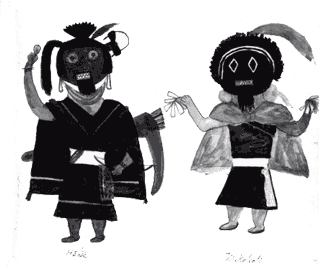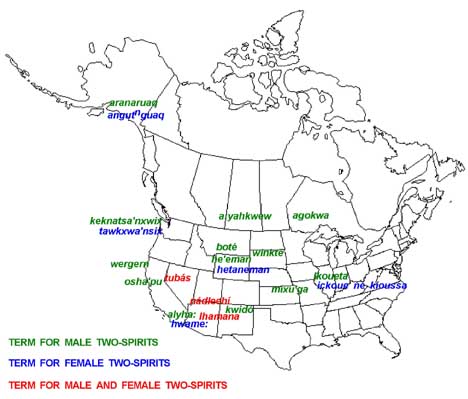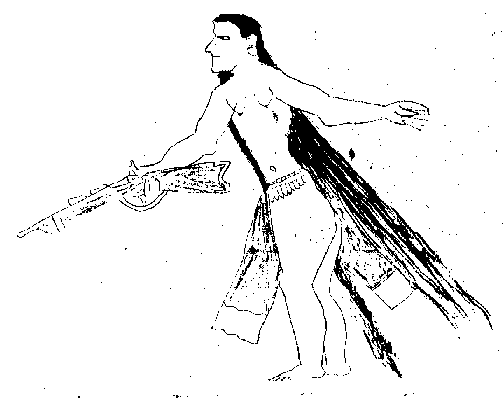Qui sont les two-spirits?

Les petits bonhommes ci-haut sont en fait ni des bonhommes ni des bonnes femmes, ce sont des personnes two-spirits (ou personnes bispirituelles ou encore "berdaches" selon la référence coloniale). Avant que les Européens n'envahissent les Amériques, il existait dans plus d'une centaine de nations amérindiennes la possibilité d'être sans genre masculin ou féminin, ou plus précisément la possibilité d'autres genres. Les two-spirits pouvaient être mariés aussi bien avec un homme ou une femme, ce qui donnait souvent naissance à des relations homosexuelles.
Est-ce qu'il reste aujourd'hui des traces ? En de rares endroits, des communautés autochtones persistent à défendre cet héritage culturel contre le rouleau-compresseur blanc. À Juchitan par exemple, qui représente la ville la plus densément peuplée par les Amérindiens en Amérique, la transgression des genres et de la sexualité continue. Cette ville, située dans le Sud du Mexique, est d'ailleurs réputée pour sa résistance légendaire aux invasions extérieures -des Espagnols, des Étatsuniens, et aujourd'hui, des fonctionnaires de l'État mexicain...
Voici en anglais un texte qui documente la réalité two-spirits plus en profondeur.
WHAT ARE TWO-SPIRITS/ BERDACHES ?

[Tribal Terms for Two-Spirit Roles]
Alternative gender roles were among the most widely shared features of North American societies. Male berdaches have been documented in over 155 tribes. In about a third of these groups, a formal status also existed for females who undertook a man’s lifestyle, becoming hunters, warriors, and chiefs. They were sometimes referred to with the same term for male berdaches and sometimes with a distinct term—making them, therefore, a fourth gender. (Thus, “third gender” generally refers to male berdaches and sometimes male and female berdaches, while “fourth gender” always refers to female berdaches.) Each tribe, of course, had its own terms for these roles, such as boté in Crow, nádleehí in Navajo, winkte in Lakota, and alyha: and hwame: in Mohave. Because so many North American cultures were disrupted (or had disappeared) before they were studied by anthropologists, it is not possible to state the absolute frequency of these roles. Those alternative gender roles that have been documented, however, occur in every region of the continent, in every kind of society, and among speakers of every major language group. The number of tribes in which the existence of such roles have been denied (by informants or outsider observers) are quite few. Far greater are those instances in which information regarding the presence of gender diversity has simply not been recorded.
“Berdache” has become the accepted anthropological term for these roles despite a rather unlikely etymology. It can be traced back to the Indo-European root *wela- “to strike, wound,” from which the Old Iranian *varta-, “seized, prisoner,” is derived. In Persia, it referred to a young captive or slave (male or female). The word entered western European languages perhaps from Muslim Spain or as a result of contact with Muslims. By the Renaissance it was current in Italian as bardascia and bardasso, in Spanish as bardaje (or bardaxe), in French as berdache, and in English as “bardash” with the meaning of “catamite”—the younger partner in an age-differentiated homosexual relationship. Over time its meaning began to shift, losing its reference to age and active/passive roles and becoming a general term for male homosexual. In some places, it lost its sexual connotations altogether. By the mid-nineteenth century, its use in Europe lapsed.
In North America, however, “berdache” continued to be used, but for a quite different purpose. Its first written occurrence in reference to third and fourth gender North American natives is in the 1704 memoir of Deliette. Eventually, its use spread to every part of North America the French entered, becoming a pidgin term used by Euro-Americans and natives alike (see Table 8.1). Its first use in an anthropological publication was by Washington Matthews in 1877. In describing Hidatsa miáti he wrote, “Such are called by the French Canadians ‘berdaches.’” The next anthropological use was in J. Owen Dorsey’s 1890 study of Siouan cults. Like Matthews, he described “berdache” as a French Canadian frontier term. Following Alfred Kroeber’s use of the word in his 1902 ethnography of the Arapaho, it became part of standard anthropological terminology.
Although there are important variations in berdache roles, which will be discussed below, they share a core set of traits that justifies comparing them:
* Specialized work roles. Male and female berdaches are typically described in terms of their preference and achievements in the work of the “opposite” sex and/or unique activities specific to their identities;
* Gender difference. In addition to work preferences, berdaches are distinguished from men and women in terms of temperament, dress, lifestyle, and social roles;
* Spiritual sanction. Berdache identity is widely believed to be the result of supernatural intervention in the form of visions or dreams, and/or it is sanctioned by tribal mythology;
* Same-sex relations. Berdaches most often form sexual and emotional relationships with non-berdache members of their own sex.
. . . In recent years, calls have been made to replace berdache with “two-spirit.” In 1993, a group of anthropologists and natives issued guidelines that formalized these preferences. “Berdache,” they argued, is a term “that has its origins in Western thought and languages.” Scholars were asked to drop its use altogether and to insert “[sic]” following its appearance in quoted texts. In its place they were encouraged to use tribally specific terms for multiple genders or the term “two-spirit.” Two-spirit was also identified as the preferred label of contemporary gay, lesbian, bisexual, and transgender natives.
Unfortunately, these guidelines create as many problems as they solve, beginning with a mischaracterization of the history and meaning of the word “berdache.” As a Persian term, its origins are Eastern not Western. Nor is it a derogatory term, except to the extent that all terms for nonmarital sexuality in European societies carried a measure of condemnation. It was rarely used with the force of “faggot,” but more often as a euphemism with the sense of “lover” or “boyfriend.” Its history, in this regard, is akin to that of “gay,” “black,” and “Chicano”—terms that also lost negative connotations over time.
The oft-cited 1955 article by anthropologists Angelino and Shedd has done much to perpetuate these misconceptions (and inspire attempts to find alternative terminology). The authors trace the term back to its Persian form but then state, “While the word underwent considerable change the meaning in each instance remained constant, being a ‘kept boy,’ a ‘male prostitute,’ and ‘catamite.’” This is certainly wrong. As outlined above, the meaning and use of the word underwent significant change when it was imported into Europe (where there were no “slave boys”) and even more change when it was carried to North America (where there was no tradition of age- or status-differentiated homosexuality). If the first generation of French visitors to North America used the term in a derogatory sense it soon lost this connotation as it came to be used not only as a pantribal term by natives themselves but as a personal name as well. There is no evidence that the first anthropologists to use the term were aware of its older European and Persian meanings. . . .
—from Changing Ones by Will Roscoe
